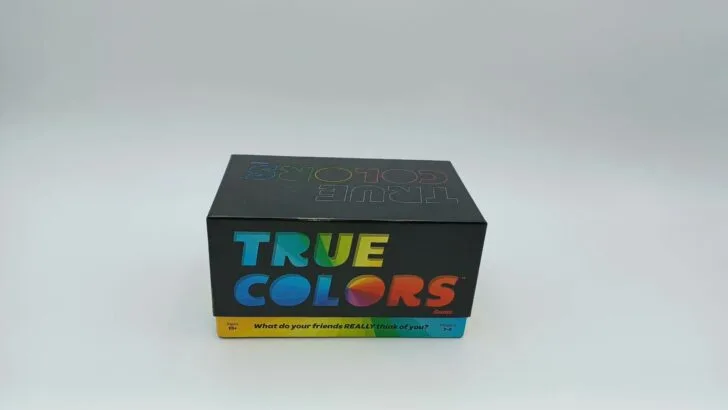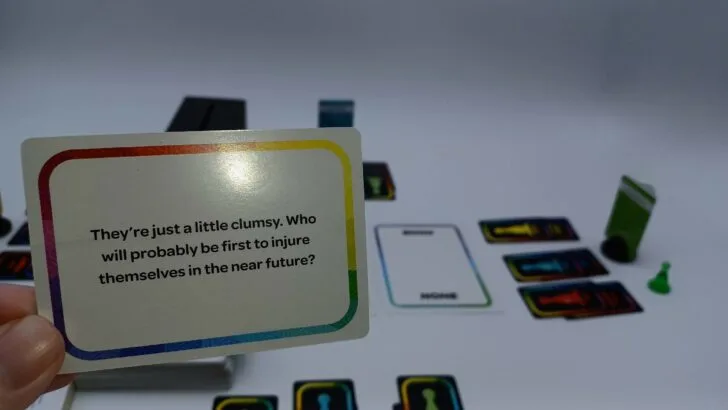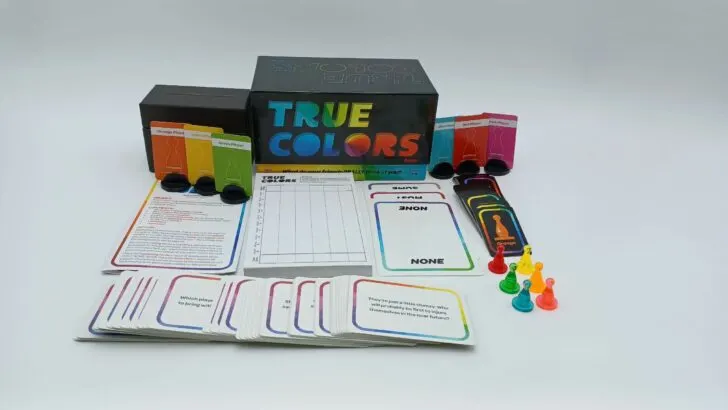True Colors How to Play Quick Links: Objective | Setup | Playing the Game | Winning the Game | FAQ | Components
Objective of True Colors
The goal of True Colors is to earn the most points at the end of ten rounds. You earn points by correctly guessing how many other players will vote for you for each of the various questions asked.
Setup
All players start by choosing a color. They then take the token and player card of that color. Put your player card into one of the mover stands and place it where it is clearly visible for all other players. If playing with less than the maximum six players take any voting cards, player cards, and tokens not used and put them back in the box. Each player takes two voting cards of each active color (except for their own color). Put the three larger “guessing cards” in the middle of the play area in this order: “most,” “some,” “none.” Also place the ballot box where all players can reach it. Finally, pick one player to act as the scorekeeper and give them the score pad. They should write each player’s initials on it. After this, the setup for True Colors is now complete.
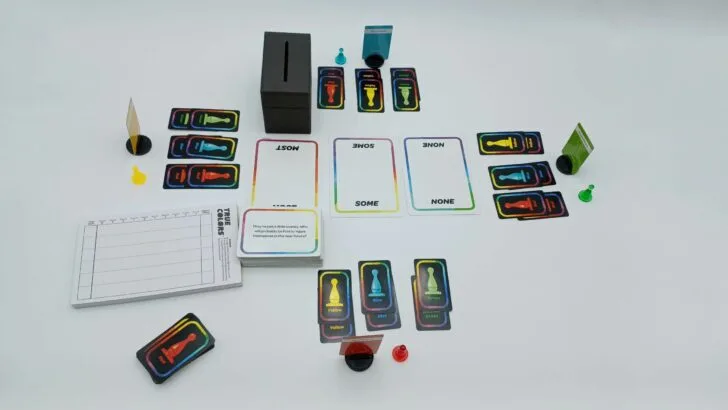
A look at the setup for a four-player game of True Colors. The cards in the lower left corner are unused colors and extras that will be placed back in the box.
Playing True Colors
Each round of True Colors consists of four actions: reading the question, voting, deciding how many votes you think you will get, and revealing the votes/scoring.
1. Reading the Question
Pick a player to select and read the first question. They pick up a question card and can decide which of the two questions to ask (either the front of the card or the back). They then read the question out loud. In subsequent rounds, the player clockwise to the previous reader reads the next question.
2. Voting
After the question is read, players secretly vote for the player they think best fits the question that was asked. They can’t vote for themselves, even if they think they fit the question the best. Players place two votes in the ballot box each round. If you are confident in your answer, you can place two of the same color voting cards in the ballot box. If you think there are two good options, you can split your vote by putting one of each color into the ballot box. Make sure to keep your votes a secret.
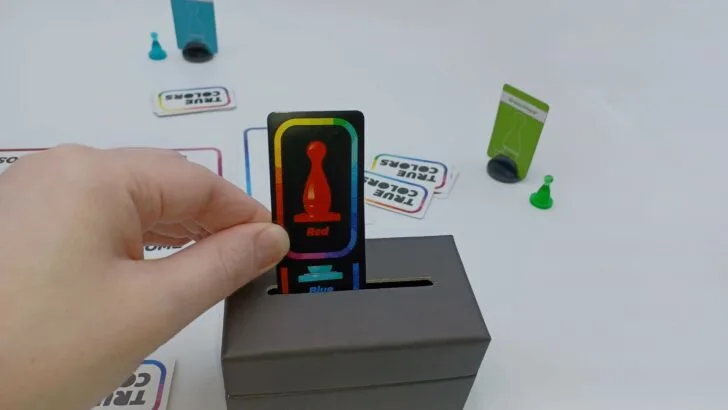
This player has decided that there are two good answers to this question and placed both a red and blue vote into the ballot box. If they felt more strongly that one player fit the question better, they could instead place two of the same color in the ballot box.
3. Guessing Round
Once all players have voted, it is now time to think about how you think your fellow players will vote. Do you think you’ll get the most votes? Some votes (at least one but not the majority)? Or none at all? Simply place your token on the corresponding guessing card. Multiple players can select the “most” option (but only one will be right). There could also be a guessing card (or cards) with no tokens on it/them, that is fine as well.
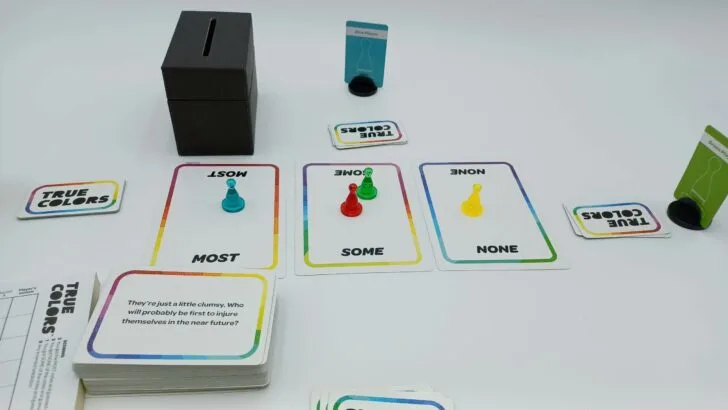
The blue player thinks they’ll get the most votes so they place their token on the “most” spot. Both green and red think they’ll get some votes while yellow doesn’t think they’ll get any.
4. Revealing the Votes and Scoring
It is now time to reveal the votes. Open the ballot box, lay the voting cards on the table, and count them up. Then, score each player’s points based on this system:
- 3 points if you got the most votes and correctly placed your token on the “most” guessing card
- 3 points if you got no votes and correctly placed your token on the “none” guessing card
- 1 point if you got at least one vote (but not the majority) and correctly placed your token on the “some” guessing card
- 0 points if you guessed incorrectly (for example, you placed your token on the “none” guessing card but got one vote)
The scorekeeper then records each player’s score for the round on the score pad.
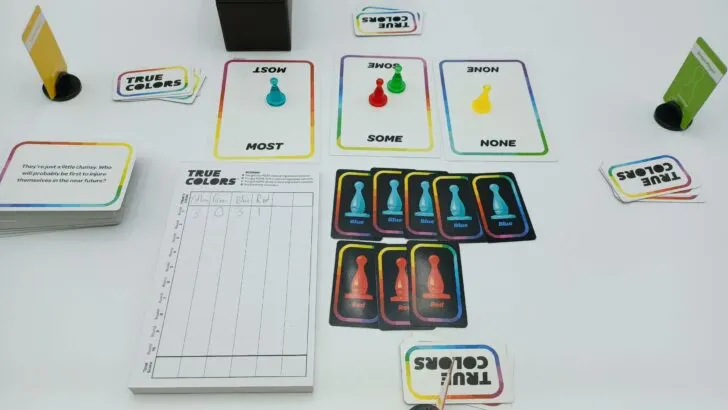
The votes have been revealed. The blue player has received the most votes (5) and the red player was the only other player to receive votes (3). The score pad has been updated to show how many points each player received. Blue and yellow get three points for correctly guessing they would get the most and no votes respectively. The red player gets one point for guessing they’d receive some votes. The green player gets nothing as they incorrectly thought they would get some votes but didn’t.
Starting a New Round
Discard the question card from the round you just played and put all used voting cards in a pile face down. To keep your votes from this round a secret, also place your unused voting cards in the pile. Then, mix the voting cards up, sort them by color, and have each player take two of each color (except for their own) just like you did to start the game. Play then continues clockwise from the previous reader (all four steps are repeated a total of ten times).
Winning True Colors
After ten rounds (questions) of True Colors, the game ends. The scorekeeper counts up all players’ scores and the player with the highest total wins True Colors.
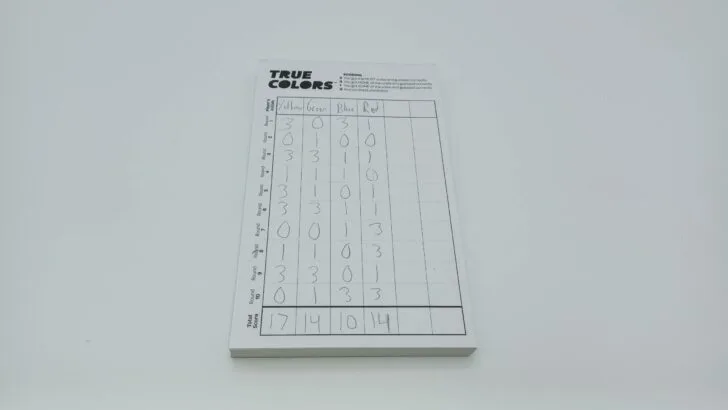
All ten rounds have been played and the scores have been tabulated. The yellow player has won the game with 17 points.
True Colors FAQ
What if there is a tie vote for “most?”
Unfortunately the official True Colors rules do not mention ties at all anywhere in the instructions manual. I personally would play it as all players tied share the “most” title and any of them that placed their tokens on the “most” guessing card receive the three points. However, the game’s rules are not specific in this area and you can play it anyway you want.
Note: If you have any questions about how to play True Colors, leave a comment below on this post. I will try to answer any questions asked as best and as quickly as possible.
True Colors Components
- 85 double-sided question cards
- 60 voting cards
- 10 orange
- 10 blue
- 10 green
- 10 yellow
- 10 pink
- 10 red
- 6 tokens (orange, blue, green, yellow, pink, red)
- 6 player cards (orange, blue, green, yellow, pink, red)
- 6 mover stands
- 3 guessing cards (“most,” “some,” “none”)
- 1 ballot box
- 1 score pad
- Instructions
Year: 2018 (Originally 1989) | Publisher: Games Adults Play (Originally Milton Bradley) | Designer: Jean Tarrade
Genres: Party, Comedy, Voting
Ages: 13+ | Number of Players: 3-6 | Length of Game: 30 minutes
Difficulty: Light | Strategy: Light | Luck: Light
Where to Purchase: Amazon, eBay – Any purchases made through these links (including other products) help keep Geeky Hobbies running. Thank you for your support.
For more board and card game how to plays/rules and reviews, check out our complete alphabetical list of board game posts.

